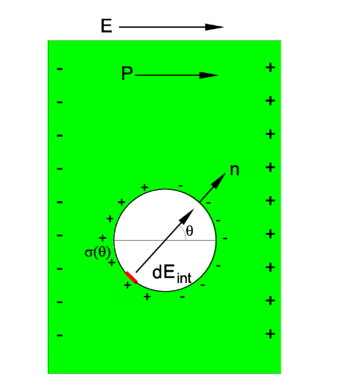Clausius-Mossotti relation
The Clausius-Mossotti relation connects the relative permittivity εr to the polarizability α of the molecules constituting a slab of dielectric.
Internal electric field in dielectric
A macroscopic slab of dielectric is placed in an outer electric field E (the z-direction) that polarizes the dielectric, so that a surface charge density σp is created. Since E "pushes" positive charge and "pulls" negative charge, the sign of the charge density on the outer surface is as is indicated in the figure. The polarization vector P points by definition from negative to positive charge. The surface charge density σp is in absolute value equal to |P|.
An infinitesimally small spherical cavity of radius r is made in the dielectric and inside this cavity there is vacuum with permittivity (electric constant) ε0. Because of electric neutrality the surface of the cavity has the charge density,
where n is a unit length vector perpendicular to the surface of the cavity at the point θ. By definition, the positive direction of the normal n is outward.
An infinitesimal element on the surface of the cavity gives a contribution to the internal electric field Eint parallel to n,
The z-component of this contribution to the field is
Integration over the whole surface gives
The total electric field in the cavity is in the z direction and has magnitude






